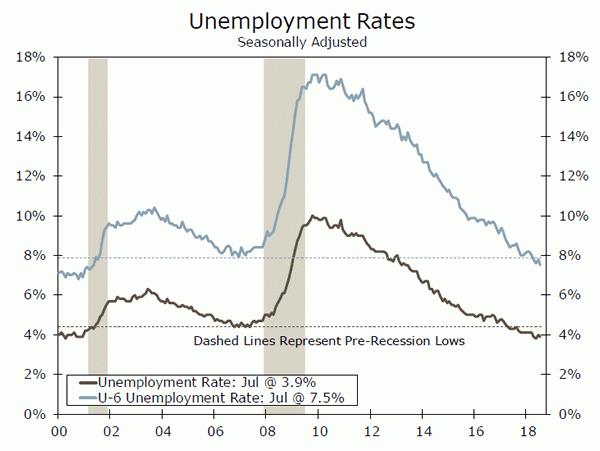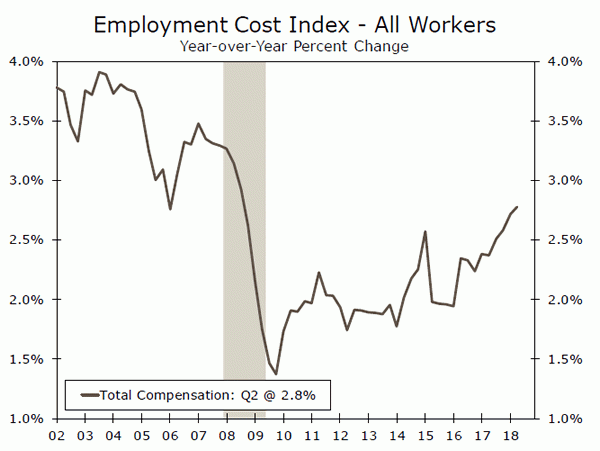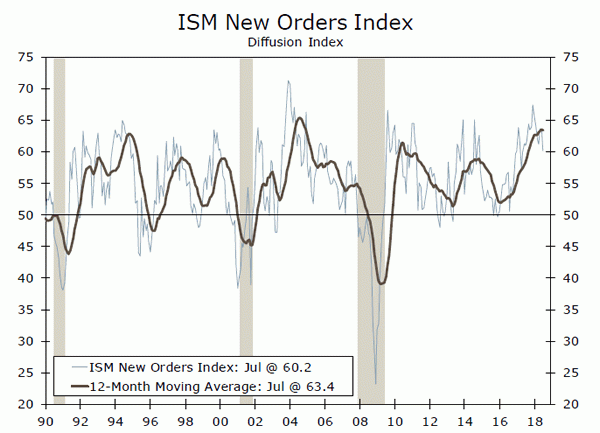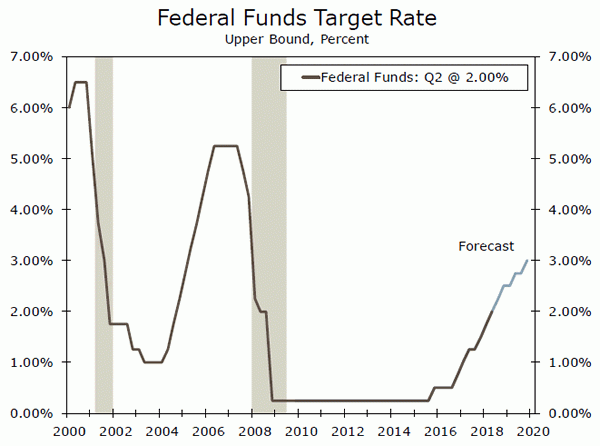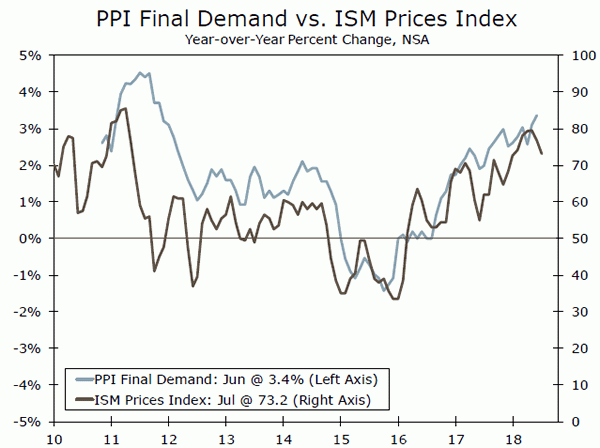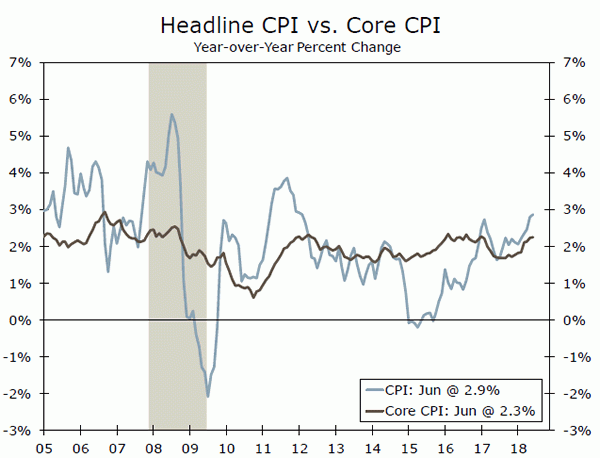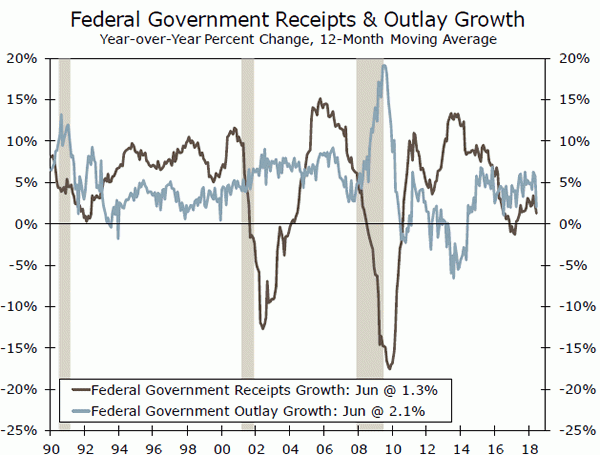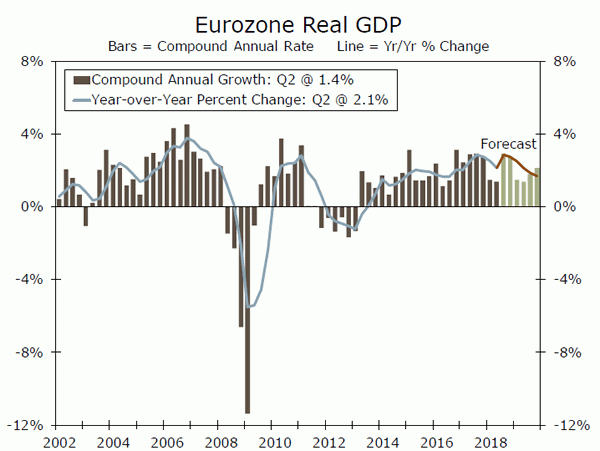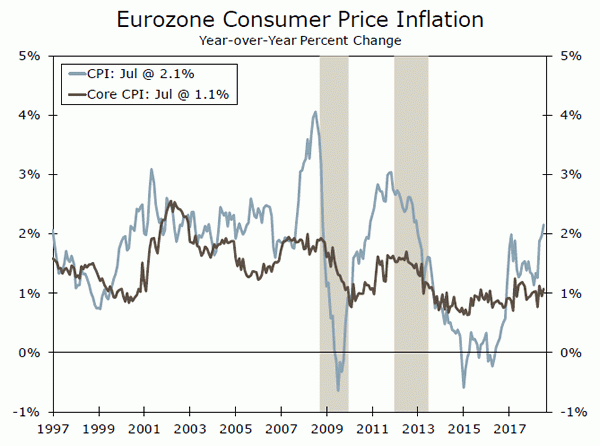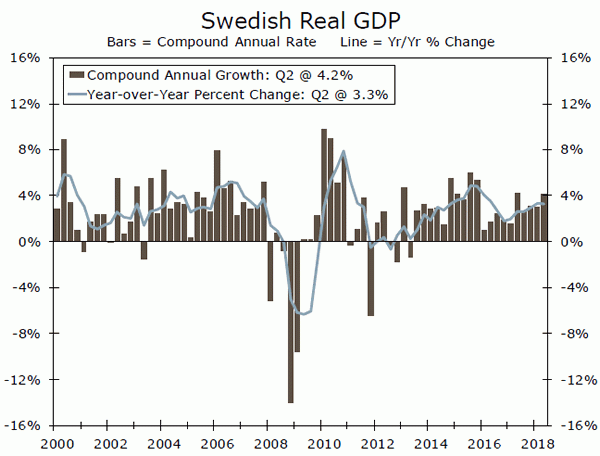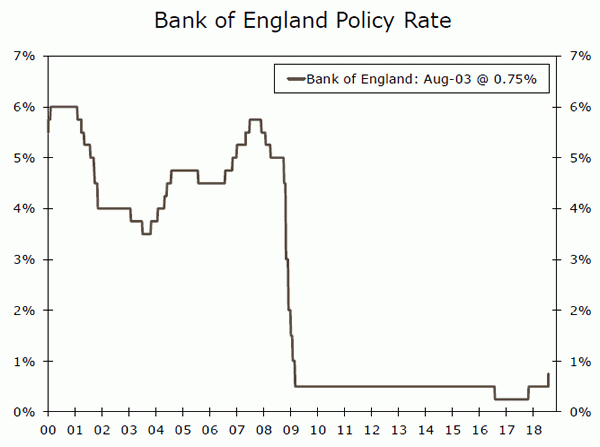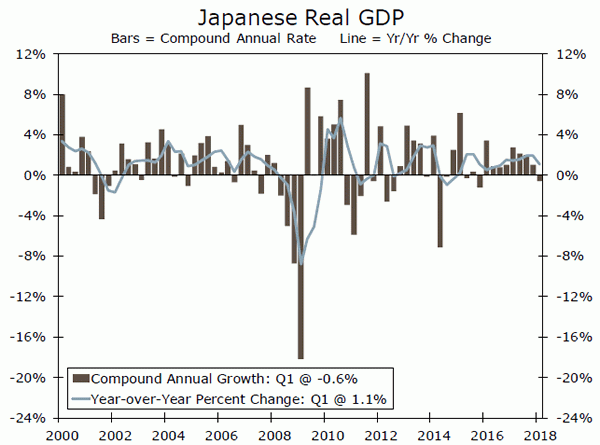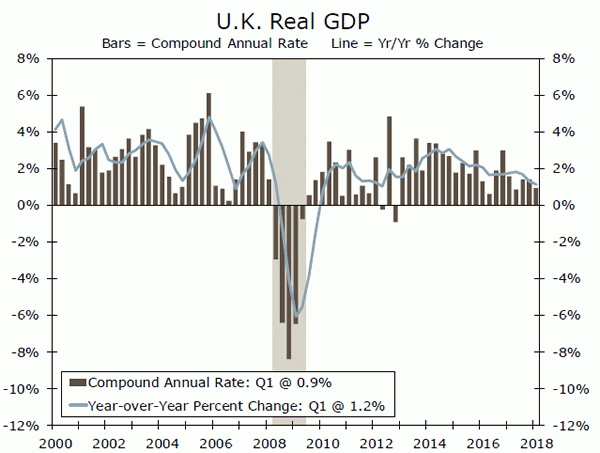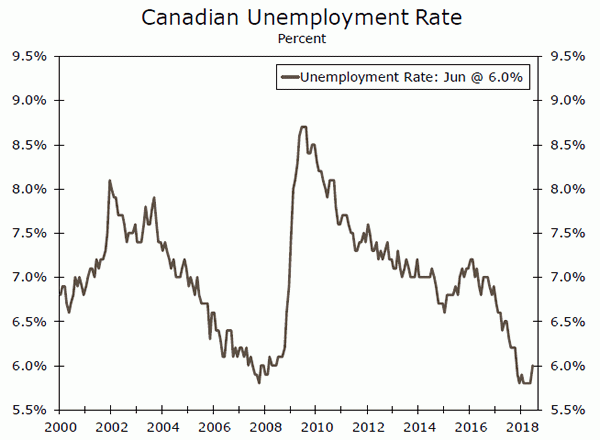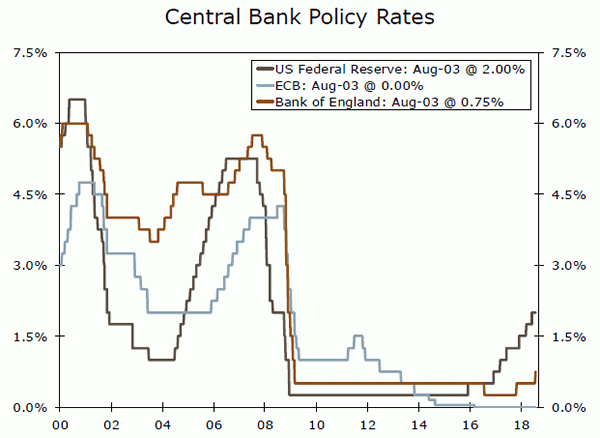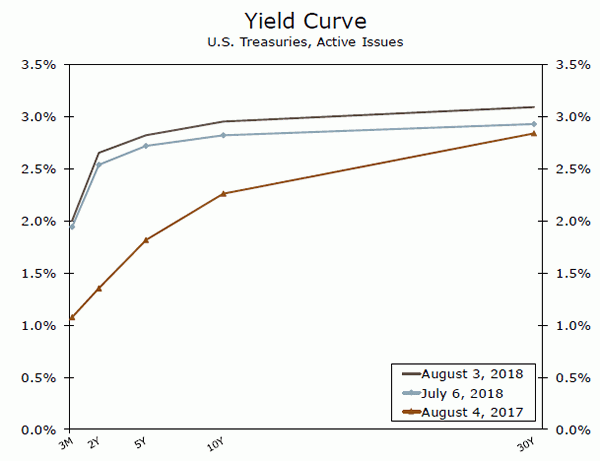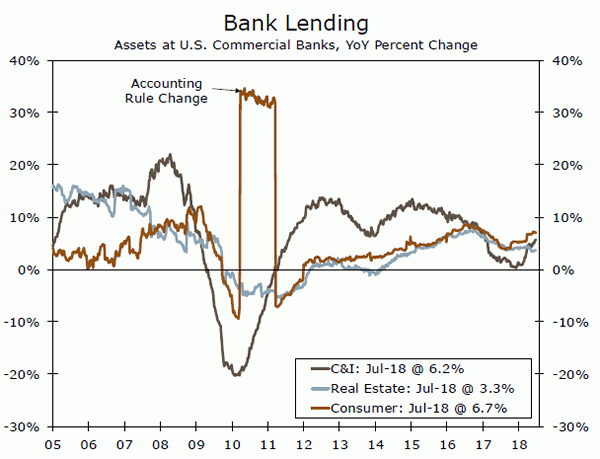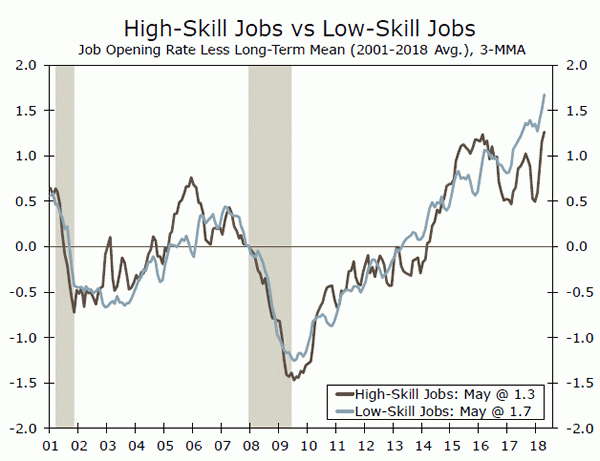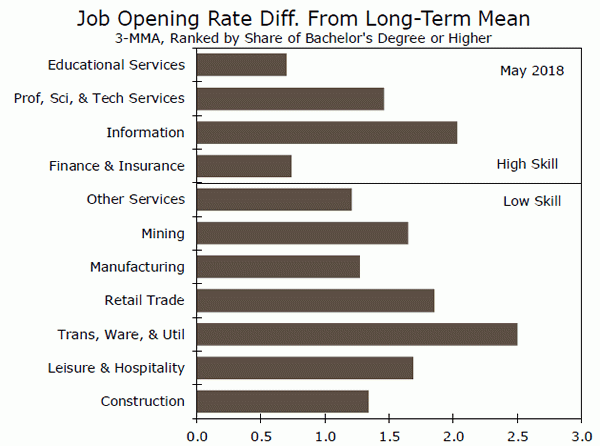U.S. Review
Data Keep Fed on Track for September Rate Hike
- The Employment Cost Index rose to its highest year-over-year pace of the expansion in Q2, signaling rising labor costs.
- The ISM manufacturing index cooled slightly in July but remained firmly in expansion territory despite recent swirling trade war concerns.
- Nonfarm payrolls were below expectations at 157,000 new jobs in July, but upward revisions to the previous two months softened the blow.
- Against this domestic backdrop, the Fed elected to remain on hold at its August meeting. We continue to expect the Fed to hike rates twice more this year in September and December.
Data Keep Fed on Track for September Rate Hike
The U.S. economic data this week were broadly consistent with a domestic economy that is grinding toward an output gap that is positive rather than negative. The Employment Cost Index rose to its highest year-over-year pace of the expansion in Q2 (top chart). Employment costs at private businesses have risen 2.9 percent amid a more rapid rise in wages and benefits. Public sector costs have been more subdued, however, as wage growth has slipped back under 2 percent. For all the hand-wringing over slow wage growth in the current cycle, there is a clear upward trend in compensation costs over the past few years (top chart). While total compensation growth remains below the previous cycle’s peak, this make senses from a fundamental standpoint given lower levels of productivity growth and inflation.
The ISM manufacturing index cooled a bit in July but remained firmly in expansion territory at 58.1. Most sub-indices moderated over the month and, along with comments from respondents, hint that the recent trade environment has begun to impact activity. The current production component edged down, and new orders fell to the lowest level in a little over a year at 60.2 (middle chart). That said, orders and activity are still at fairly high levels, and the modest slowdown of late does not look problematic for the overall growth picture. Similarly, the consumer confidence index was only slightly down in June and July relative to May despite rampant headlines over the past two months about a possible trade war. Like the Fed, we will be watching the data closely to see if trade concerns begin to bear down more noticeably on broad activity.
U.S. employment data for July were released this morning. Nonfarm payrolls growth disappointed with a 157,000 print, below the 193,000 Bloomberg consensus estimate. The net revisions over the previous two months were +59,000, however, softening the blow of the miss. Manufacturing payrolls were particularly strong, rising 37,000 in July, the fastest pace of 2018. The unemployment rate dipped to 3.9 percent, while average hourly earnings were unchanged at 2.7 percent year over year. One encouraging sign was the broader U-6 unemployment rate, which counts those working part-time for economic reasons and those who want a job but have stopped looking, reaching the lowest level since 2001 (see chart on front page).
Against this domestic backdrop, the Fed elected to remain on hold at its August meeting, which concluded this week. In our view, the FOMC upgraded its assessment of the economy compared to the statement that was released at the end of the last meeting in June. When describing growth, the FOMC upgraded its characterization of the pace of economic activity from “solid,” which it used in the last policy statement, to “strong.” Trade tensions continue to lurk in the background for the Fed, but with inflation more or less at target and economic growth proving robust, we believe the Fed will hike twice more this year in September and December (bottom chart). Still, with wage growth only slowly grinding higher and the core PCE deflator remaining just shy of target at 1.9 percent yearover- year through July, the impetus for the Fed to accelerate its tightening plans likely remains missing for the time being.
U.S. Outlook
Producer Prices • Thursday
Producer price inflation has been strengthening over the past year, with the PPI up 3.4 percent year over year. A 50 percent rise in oil prices over the year has helped drive the gain, but PPI ex-food, energy, and trade services (measured by margins) has increased 2.7 percent from a year ago.
We expect PPI to rise 0.2 percent in July as domestic capacity constraints intensify and additional tariffs, which provide scope for U.S. producers to raise prices, take effect. Businesses report input prices rising broadly. The ISM manufacturing prices paid index came in above 70 for a seventh straight month, while the share of nonmanufacturers reporting higher prices also remains elevated. Rising material and labor costs for U.S. producers should push core PPI up further in the coming months.
Previous: 3.4% Wells Fargo: 3.4% Consensus: 3.4% (Year-over-Year)
Consumer Prices • Friday
Consumer price inflation came in a touch softer than expected in June amid a pullback in energy prices and subdued increase in core services. We expect to see the CPI advance 0.2 percent in July, however, as gasoline prices fell less than usual for this time of year. That should keep headline CPI up 2.9 percent on a year-ago basis. We estimate the non-seasonally adjusted index rising to 252.238.
Core inflation is also expected rise, but will likely be closely in line with its recent trend and print a “low” o.2 percent. Last month the index was dragged down by a sharp drop in hotel costs, which is unlikely to be repeated to the same extent. Meanwhile, homeownership costs, which account for nearly a quarter of the CPI, show no signs of slowing. Prices for new and used autos are also firming up as inventories have come down over the past year.
Previous: 0.1% Wells Fargo: 0.2% Consensus: 0.2% (Month-over-Month)
Monthly Budget • Friday
The federal budget posted a deficit of $75 billion in June. Despite the strongest four-quarter run in nominal GDP growth since 2006, federal receipts are up only 1.3 percent over the past year (on a 12-month moving average basis) as tax changes have led to a steep decline in corporate tax receipts. Individual tax receipts—up 16 percent fiscal year to date—however, have helped ease some pressure on the budget.
Thus far this fiscal year, the deficit is about $80 billion wider than last year, with one quarter still to go. Outlays from the budget deal reached in March are beginning to ramp up, and we expect the third quarter to be the near-term peak in the pace of government consumption and investment. With only three more months left in the fiscal year, that should propel the deficit toward $800 billion for the year as a whole.
Previous: -$74.9B
Global Review
Eurozone GDP Growth Slows Modestly in Q2
- Amid several international data releases this week, GDP growth in the Eurozone decelerated slightly to 2.1 percent (year over year). Although the Q2 print came in a bit below consensus estimates, we look for the expansion to remain intact, buoyed by gradually rising wages and a tight labor market.
- Q2 GDP in Sweden remained strong, growing 3.3 percent year over year. Rising inflation looks to be supportive of gradual monetary policy normalization in coming quarters.
- Both the Bank of England and Reserve Bank of India raised rates this week, while the Bank of Japan remained firmly accommodative, making only minor policy adjustments.
Eurozone GDP Growth Slows Modestly in Q2
Several Q2 GDP releases and central bank announcements flooded the international arena this week. In the Eurozone, Q2 GDP growth fell a bit short from consensus expectations, and at 2.1 percent (year over year) represents a continued deceleration from the more rapid 2.8 percent rate registered in Q4-2017 (see chart on page 1). But the underlying economic expansion should remain intact. The manufacturing and consumer sectors were both likely solid performers in Q2, and along with gradually rising wages and a tight labor market should propel economic growth in coming quarters.
However, inflation remains lackluster and continues to restrain the removal of monetary policy accommodation on the part of the European Central Bank (ECB). While headline inflation has returned to the ECB’s 2 percent target in recent months, core inflation remains stuck around 1 percent (top chart). We take the ECB at its word that it will end bond purchases by the end of this year. Assuming GDP growth and inflation continue to pick up, we look for the ECB to begin raising rates in early autumn 2019.
Elsewhere in Europe, real GDP in Sweden rose strongly in Q2, with the 3.3 percent year-over-year increase surpassing consensus estimates (middle chart). Inflation in Sweden has also picked up and looks to be supportive of the country’s central bank gradually removing policy accommodation in the near future.
Monetary Policy Convergence Poised to Return in H2
The trend toward global monetary policy convergence looks poised to pick back up in the second half of the year after pausing amid a slowdown in global growth in H1. The Bank of England (BoE) raised rates 25 bps after remaining on hold since November 2017 (bottom chart). While economic growth in the U.K. was slower than expected in Q1, the BoE characterized the deceleration as only temporary, and continued to state that “the economy has a very limited degree of slack.” Inflation also remains above the BoE’s 2 percent target in the wake of sterling depreciation following the Brexit Referendum in 2016. But the BoE looks for domestic cost pressures to pick up, while external factors pushing up prices should continue to subside. Although uncertainty surrounding Brexit negotiations has increased recently, the BoE remains of the view that sustained economic growth warrants further rate increases to support its inflation target. Assuming this occurs, we look for the BoE to continue to gradually tighten policy.
The Reserve Bank of India (RBI) also hiked two of its main policy rates 25 bps each at its meeting this week. Inflation reached 5 percent in June, and the RBI also noted a significant rise in core inflation, which, along with solid economic growth, positions the RBI to raise rates further in coming quarters.
While the BoE and RBI raised rates, the Bank of Japan (BoJ) remains a laggard. Although the BoJ made minor adjustments at its meeting this week to allow a greater degree of variation around its 10-year government bond yield target, its monetary policy remains highly accommodative. Given continued low inflation and downward revisions to its inflation forecasts this week, we look for the BoJ to maintain its policy stance for the foreseeable future.
Global Outlook
Japanese GDP Growth • Thursday
Real GDP in Japan edged down 0.6 percent (annualized rate) in Q1-2018, the first contraction on a sequential basis in more than two years. Most analysts, ourselves included, look for output to have bounced back in the second quarter. Industrial production jumped 2.0 percent (not annualized) in the first two months of Q2 relative to the first quarter, and the nominal value of retail spending climbed 0.4 percent in the second quarter on a sequential basis. In our view, the mild contraction in real GDP in the first quarter was an aberration rather than the start of a trend.
That said, we do not look for explosive Japanese economic growth anytime soon. Some market participants had speculated that the Bank of Japan would signal at its policy meeting this week that it was prepared to dial back policy accommodation. In the event, the BoJ decided to continue targeting the long end of the yield curve because inflationary pressure still remains dormant.
Previous: -0.6% Wells Fargo: 1.5% Consensus: 1.3% (SAAR)
U.K. GDP Growth • Friday
U.K. real GDP rose at an anemic rate of only 0.2 percent (0.9 percent annualized) in the first quarter. Data that are slated for release on Friday should show that GDP growth strengthened in the second quarter. Although the U.K. economy probably accelerated in the recently completed quarter, growth likely will remain generally sluggish until some of the Brexit-related uncertainty is cleared up. With no resolution of the eventual trading relationship between the United Kingdom and the rest of the European Union on the horizon, we forecast that British economic growth likely will remained muted.
Although the GDP release should be the highlight of the week, June data on industrial production, construction output and the trade balance should add some further insights into the current state of the British economy.
Previous: 0.2% Wells Fargo: 0.4% Consensus: 0.4% (Not Annualized)
Canadian Employment • Friday
Canadian employment rose by 31.8K workers in June. Because the population of the United States is about ten times as large as Canada’s, the rise in Canadian non-farm payrolls in June is equivalent to a very strong gain of roughly 300K workers in the United States. Canadian employment is inherently volatile on a monthly basis, so the unemployment rate, which is not quite as volatile, may be a better way to measure the underlying state of the Canadian labor market. In that regard, the current rate of 6.0 percent is near the lowest rate in more than 40 years. In short, the Canadian labor market is tight at present.
The Bank of Canada (BoC) raised its main policy rate 25 bps at its last policy meeting on July 11. In our view, there is a low probability that the BoC will hike rates again at its next policy meeting in September, but we forecast that it will pull the trigger again at one of its two meetings in the fourth quarter.
Previous: 31.8K
Point of View
Interest Rate Watch
Gradual Remains The Key Phrase
This past week’s FOMC meeting contained few surprises, and the Fed remains on track to boost interest rates another quarter percentage point in September. The policy statement that followed the meeting contained only a couple of notable changes. Household spending and business investment are now noted to have grown “strongly” during the first half of the year rather than solidly. You would expect nothing less than that, given that the advance estimate of real GDP showed the economy growing at a 4.1 percent annual rate. Apparently, 2 to 3 percent growth is considered solid.
The other notable change has to do with inflation, with the policy statement noting that on a 12-month change basis, both overall and core inflation data remain “near” 2 percent. The message here is that the Fed is not likely to ramp up the pace of tightening from its current gradual pace even if the inflation numbers rise a little above 2 percent for a while. Chairman Powell and several other Fed officials have often noted than inflation has been below the 2 percent target for many years and that a short-term rise above that level should not be all that troubling.
Beyond September, we see the Fed nudging the federal funds rate up another quarter point in December. While another hike seems fairly certain, it could possibly be undone if the economy were to suddenly lose momentum. We view that as unlikely, however, and have real GDP rising at better than a 3 percent pace during H2-2018.
The yield curve flattened slightly following the smaller-than-expected rise in July nonfarm payrolls. The smaller gain suggests economic growth is moderating, but not so much that it will cause the Fed to put off raising the federal funds rate target in September and December.
The yield on the 10-Year Treasury briefly reached 3 percent this week, pushed higher by concerns that the Treasury will need to borrow significantly more money during the second half of the year to finance larger budget deficits. The Treasury remains reluctant to push more bond issuance into long-term maturities, however, which is keeping the yield curve relatively flat.
Credit Market Insights
Growing Concern Over Farm Loans
Agriculture prices have suffered in recent years, as global commodity prices collapsed. The USDA crop prices index increased in 2017 and so far in 2018, but remains 15 percent below its 2012 average after four consecutive years of lower prices. Declining commodity prices had been one factor holding back headline inflation, which only reached the Fed’s 2 percent target this year. Another less-widely discussed impact has been on farm credit.
The USDA forecasts net farm income to reach a 12-year low in 2018, largely due to low commodity prices. As farms bring in less revenue, more are using loans to cover costs. As of Q2, farm loan volume increased 2.3 percent from a year ago and more than 8 percent from the previous quarter, largely driven by loans for operational expenses.
An area of potential concern, given lower farm incomes and higher farm loan volumes, is rising interest rates. Loan repayment rates have continued to decrease, largely due to higher interest rates, according to the Kansas City Fed Databook. The USDA forecasts crop prices to increase in 2018 and 2019, which should help farms on the revenue side. However, tariffs have recently pushed down prices for some crops, including soybeans. Relief may still be some ways off.
Farm loans make up less than 2 percent of all commercial bank loans. Thus, concern over farm credit does not weigh heavily on the overall health of the credit market, but may have larger regional impacts.
Topic of the Week
The Low-Skill Labor Crunch
Though employment growth slowed in July, the trend remains solid and is fast enough to continue lowering the unemployment rate. As of May, there is less than one unemployed worker per job opening. The NFIB small business survey reported 37 percent of firms claiming hard to fill job openings as their most important problem.
To understand where labor shortages are being felt most acutely, we calculate an adjusted job opening rate for each industry. We subtract the long-term mean from each opening rate to control for the fact that “natural” opening rates vary by industry. While we recognize that education does not necessarily equate to skill, for the purposes of this analysis, we classify sectors into “lower-skill” and “higher-skill” using the share of employees with a bachelor’s degree as a proxy.
The adjusted job opening rates for lower-skill and higherskill industries are at all-time highs (top chart). However, the labor market for lower-skill jobs looks to be tightest. The lower-skill adjusted job opening rate has continuously trended upward in recent years, and the highest industry-specific rates are clustered in the lowerskill category (bottom chart). The transportation, warehousing & utilities sector stands out for having the highest adjusted rate, while openings in the retail sector are also elevated. Higher-skill jobs are not immune from worker shortages, however; openings in the information industry are particularly high.
Low wages may be discouraging workers from pursuing careers in fields with some of the highest opening rates. Average hourly earnings in transportation & warehousing and retail trade are below the national average, and wage growth has also lagged. In addition, lower labor force participation rates for workers with less education may be exacerbating labor shortages in lower-skill industries.
We expect the unemployment rate to continue its downward trend as hiring outpaces labor force growth. Employers are likely to continue to ease job requirements and increase wages and benefits to address difficulties.




